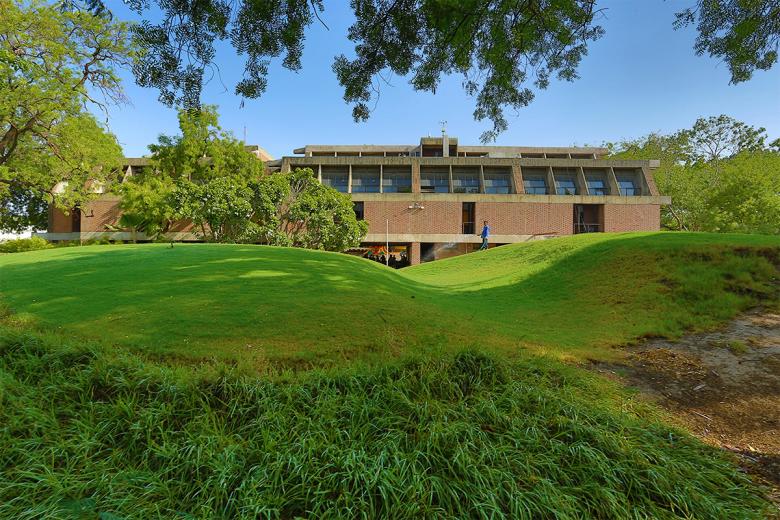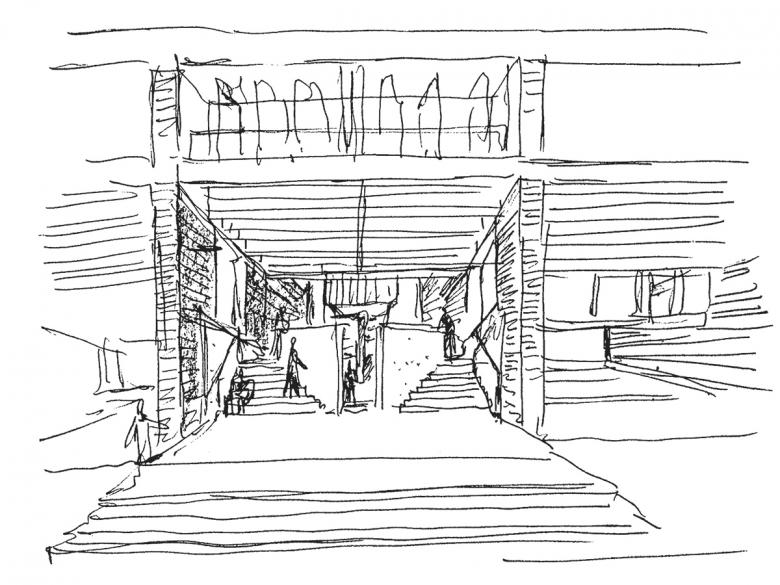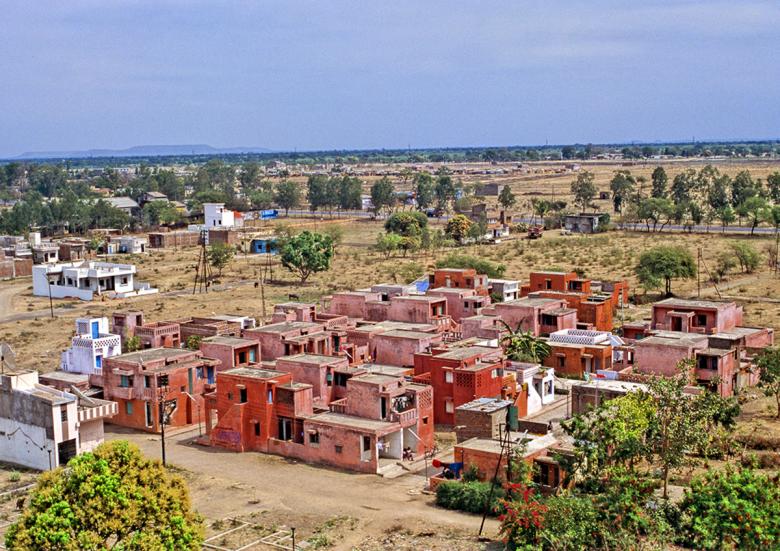3 Masterpieces by Balkrishna Doshi
Last week, 90-year-old Indian architect Balkrishna Doshi was named the 2018 laureate of the Pritzker Architecture Prize, considered the profession’s highest honor. Here we highlight three of Doshi’s masterpieces: a university realized over five decades; low-cost housing; and his own architecture studio.
Born in Pune in 1927, Doshi attended the Sir J.J. School of Architecture Bombay (Mumbai) twenty years later but then left in 1950 to pursue an advanced architectural education in London. There he met Le Corbusier and worked in his Paris studio, when the master architect happened to be designing a number of projects for India, most notably the city of Chandigarh. Doshi moved back to India in 1955, overseeing Le Corbusier’s projects in the country and settling in Ahmedabad. His early independent projects were highly influenced by Le Corbusier, but eventually Doshi would form his own office, Vastu Shilpa, and craft his own style, combining modern forms and materials with regional influences arising from environmental conditions and an awareness of how people lived.
This assertion is echoed by the words of the Pritzker Prize jury, who said in last week's announcement:
It’s these social and environmental considerations that lie at the heart of Doshi’s long, seven-decade career – and the three projects highlighted here.Over the years, Balkrishna Doshi has always created an architecture that is serious, never flashy or a follower of trends. [He has] a deep sense of responsibility and a desire to contribute to his country and its people through high quality, authentic architecture ... Doshi is acutely aware of the context in which his buildings are located. His solutions take into account the social, environmental and economic dimensions, and therefore his architecture is totally engaged with sustainability.
Center for Environmental Planning & Technology
A few years after his apprenticeship with Le Corbusier, Doshi and several colleagues established the Ahmedabad School of Architecture, which became the Center for Environmental Planning and Technology (CEPT), comprised of the school of architecture, as well as those of planning, building science and technology, and interior design. The School of Architecture (photo above), completed in 1968, exhibits the influence of Le Corbusier (it's considered a reworking of his College of Art in Chandigarh) but also Louis I. Kahn, who Doshi helped bring to India and worked with on the Indian Institute of Management in Ahmedabad. To cut down on sunlight while admitting natural ventilation, he designed a structure of parallel brick walls and deep concrete columns that recall Corbu's brise-soleil but also Kahn's rigorous order.
Doshi's departure from the two modern masters he was fortunate enough to have worked with is evident in the circulation spaces sketched above and photographed below. The architect has said, as quoted in William J.R. Curtis's 1988 monograph on Doshi, "As with Le Corbusier's Unité d'Habitation or Villa Savoye, the building is raised up above the ground. But here the space underneath is active and multi-functional, designed for sun protection and exposure to the breeze." So, where Corbu lifted the building to express the ground floor's independence from those above it, Doshi elevated the school in response to India's hot climate and to enable a hub of activity where shade and breezes create a comfortable environment.
From its founding in 1962 to 2012, CEPT expanded under Doshi, who served as campus architect and is now Dean Emeritus. A more recent contribution to the campus (1990s), and one that departs dramatically from the earlier Corbu/Kahn-inspired designs is Amdavad ni Gufa, an underground gallery that houses the works of the Indian artist Maqbool Fida Husain. Built by locals as ferrocement shells covered with porcelein tiles, the gallery animates, in Doshi's words to the Pritzker Prize, "the mysteries of light and memories." Furthermore, "Challenges between an artist and an architect give birth to the most unexpected. Searching the uncommon meant raising fundamental questions – what is the meaning of function, space and technology – amidst structure and form."
Aranya Low Cost Housing
Two decades after building the School of Architecture in Ahmedabad, but two decades before fellow Pritzker Prize winner Alejandro Aravena would realize his own form of incremental housing in South America, Doshi planned Aranya, low-cost housing with 6,500 planned residential units in Indore, about 250 miles (400km) east of Ahmedabad. Aranya was predicated on a "sites and services" approach, in which electricity, water, and sewer services were provided, but the houses were built minimally as a services core (plumbing, washroom, kitchen) and a single room that each family could extend. Carried out by Doshi's Vastu Shilpa Foundation (VSF) and realized first as a demonstration project in one sector, Aranya Low Cost Housing earned Doshi his first (and only) Aga Khan Award for Architecture, in 1996.
Aranya was developed as an alterntive to the slums prevalent at the time, and VSF's plan was based on years of research, out of which came a number of documents, most notably the three-part How the Other Half Builds, whose name reference Jacob Riis's pioneering How the Other Half Lives. Their research led to the "site and services" approach but also an informal plan departing from modernist grids and a hierarchy of streets that diminish in size as one delves deeper into each neighborhood, or sector. The intimate – yet far from crowded – scale of the project is evident in the highly social streetscapes defined by the small balconies and the front steps drawn and photographed here.
But how did Aranya work? How did poor families expand their houses over time? Doshi laid out four objectives for Aranya and one of them – "create a balanced community of various socio-economic groups" – enabled high-income buyers to subsidize loans for the lower-income properties; any funds that went beyond the average plot cost went into a common trust that the poorer families could use to buy and expand their homes. Furthermore, the lower-income residences were distributed evenly among Aranya's six sectors, rather than all in one sector; service charges were scaled to income level; and training centers were provided for residents to gain construction skills. Most importantly, the plan acknowledged that architecture is only one element in building a successful neighborhood.
Sangath Architect's Studio
Sangath is Doshi's architecture studio and the headquarters of the Vastu Shilpa Foundation. Meaning "moving together through participation" in Sanskrit, Sangath nearly embodies the whole essence of Doshi's long career. (Vastu Shilpa, it should be noted, means "design of environment" in Sanskrit.) Although the barrel-vaulted forms of the parallel volumes immediately recalls Louis I. Kahn's Kimbell Art Museum in Fort Worth, Texas, the landscape is key at Sangath. Kahn's assertion, as paraphrased by Doshi biographer James Steele, "that the first school began when a person who did not realize he was a teacher began to speak to people who didn't know they were students under a tree," comes across in Sangath's amphitheatre, a feature all visitors must pass before entering the building. This is no accident: not only did Doshi co-found an architecture school, he has taught for most of his career.
Also recalling vaulted spaces by Corbu, such as Sarabhai's House in Ahmedabad or Maisons Jaoul in Paris, the project more importantly embraces his "promenade architecturale." Grasped in both the rich drawing above and the words of Doshi giving a tour of Sangath (worth watching – at least the first 14 minutes), Doshi takes visitors on a circuitous route from the entry gate off Ahmedabad's Drive Inn Road, past the footprint of a departed mango tree, along a path that frames the pleasing view in the photograph above, and eventually to the studio's submerged entrance. The building is surrounded by tall buildings and it easily could have been taller, but Doshi maintained about 60% open space and embedded the building in the earth, reducing the scale of the building but also cooling the interior spaces.
Doshi revealed to Steele how the vaulted form didn't owe a debt to either Le Corbusier or Kahn. Instead, when he was designing an earlier outhouse on the site, the contractor only had curved corrugated sheets for the roofing. Much to Doshi's wonder, he "found that the proportions of the vaulted roof in relationship to the base were similar to Indian temples and sought to recreate this proportion at a larger scale when designing Sangath." Combined with details like the figural statue at the entrance (photo below), the architecture bridges modernity and tradition. In that sense, Sangath embodies Doshi's whole oeuvre, which refused to dispatch with the social and environmental forms of Indian culture in exchange for the homogenizing effects of modernity.












